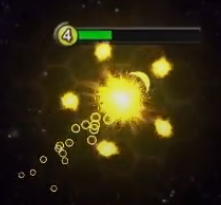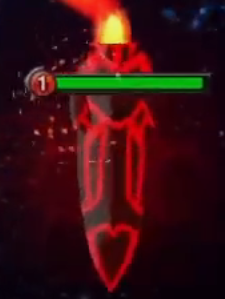ZeroLancer
Role: Solo Developer (Mostly)
Genre: Top-Down Shooter, Couch-Multiplayer (2-4 players)
DEC 2012 - MAY 2013
ZeroLancer was one of my college game projects, and probably the one I’m most proud of, largely because it was essentially a solo project, created in Digipen’s proprietary ZeroEngine. I handled design, scripting, VFX, audio design (using free libraries), UI, and most of the art, with some limited 3D modeling assistance from friend and fellow designer Aaron Johnson.
ZeroLancer was a chance for me to dig deep and explore asymmetrical combat design, which was a big challenge as relatively inexperienced designer, and a lot of fun. Each ship has a unique set of weapons and custom motion model, and approaches combat in a distinct way. Four ship types were included at completion, which the players select fighting-game style before a match, and three levels, each with various traps, hazards, and power-ups available. The controls were extremely simple: Left Stick for movement, 2-3 face buttons for weapons, and the start button to pause.
I spent a lot of time playtesting in the public computer labs on the Digipen campus, where there were plenty of TVs and couches to commandeer, and just watching people play and taking notes. My design goals were pretty simple:
1. Keep it simple enough that the game needs no tutorial or explanation. Players could just pick up a controller and figure it out.
2. Make it fun enough that players would willingly and voluntarily play multiple rounds without me prompting them.
3. Balance it well enough that you could win with any ship (mostly).
The first two I feel I accomplished, but the last was the tricky, given the wildly different abilities the ships have. Among repeat testers, especially in 1v1 fights, there were some clear frontrunners. Less so in four-player Free For All matches, where chaos evened things out more, and the fact that this was the primary game mode meant the issue was overall less glaring than it might have been, but nevertheless I never quite achieved the level of balance I was hoping for.
The Promethean (left) was the most favored by repeat-testers. Despite being fragile and having a slow base speed, its teleportation weapon made it so quick and maneuverable that if a skilled player was piloting it, the Promethean was very difficult to pin down, especially because it was extra-effective at avoiding the rotating laser hazards on several of the maps. This maneuverability was supposed to be offset by its fragility and short-range weapons, but in practice they weren’t enough to stop this little beast from dominating the arena.
The Cruiser (left) was a close second, boasting high health and a fast charging attack, which let it easily outpace most of the other ships. Being less capable of crossing hazards was a detriment, but being able to outrun anything and everything made it tough to deal with. I added some drawbacks (its charge attack destroys pickups rather than collecting them, preventing it from stealing every health orb unchallenged), but in the end speed
It’s easy to see in hindsight that giving some sort of comparable movement abilities to the other two ships (the Deltawing and the Sentinel, the triangular missile-based ship and the pincer-shaped long-range laser ship, respectively), would have been the quickest route to evening them out, power-wise, but at the time I was convinced I could make up the difference with sheer firepower (Delta) and utility (Sentinel), which was unsuccessful. Maneuverability was just too important, both in direct combat and to avoid the prominent (and deadly) map hazards. Beyond that: introducing some more balance levers (such as an energy meter, or weapon cooldowns) might have let me fine tune things more, but I do like the simplicity of the game as it stands, where every button always performs its action without regard for resources, and though it made my job harder, I’m glad I avoided resorting to them at the time.
Tech-wise, everything was scripted in Python, and ZeroEngine offered a basic 3D level-editor and some tools for creating simple particle systems. Imagine a sort of stripped-down version of Unreal or Unity.


